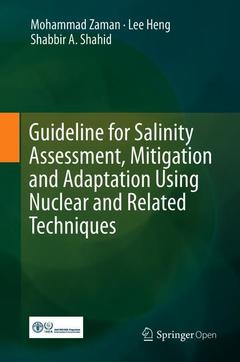Guideline for Salinity Assessment, Mitigation and Adaptation Using Nuclear and Related Techniques , 1st ed. 2018
Auteurs : Zaman Mohammad, Shahid Shabbir A., Heng Lee

Chapter – 1: Introduction to Soil Salinity, Sodicity and Diagnostics Techniques.- Chapter – 2: Soil Salinity: Historical Perspectives and a World Overview of the Problem.- Chapter – 3: Salinity and Sodicity Adaptation and Mitigation Options.- Chapter – 4: Irrigation Systems and Zones of Salinity Development.- Chapter – 5: Irrigation Water Quality.- Chapter – 6: The role of Nuclear Techniques in Saline Agriculture.
Mohamed Zaman completed a PhD degree at Lincoln University, Canterbury, New Zealand on soil nitrogen (N) mineralization and its relationship to soil microbial and enzyme activity in grasslands under different management practices. After completing his PhD, Zaman continued postdoctoral research at Lincoln University in the areas of soil fertility and soil water quality, using both conventional and stable isotopic techniques. He then moved to Japan and worked with researchers from Chiba University, Chiba Prefecture Agricultural Research Station and the University of Tokyo on N dynamics and greenhouse gas emissions from upland soils using 15N as an isotopic trace. After two years in Japan, Zaman went back to New Zealand to take up a position as a researcher in the National Institute of Water & Atmospheric Research (NIWA), Hamilton. He then moved to the farmer owned cooperative fertilizer Industry, firstly as a Senior Scientist (5 years) and then as a Research Manager (4 years) to increase the adaptive capabilities of soil/plant systems to climate change and to enhance nutrient use efficiency on farms. This research included mitigating greenhouse gas (GHG) emissions in an integrated plant animal system, developing new decision support systems and tools, identifying novel products to increase farm productivity and resource use efficiency, and minimizing nutrient losses to waterways and the atmosphere. During this 9 year period at the Fertilizer Industry and the farming community, Zaman established an international network of academic researchers from New Zealand, Australia, Canada, China, Japan, Pakistan and USA to investigate fertilizer management techniques to increase nutrient use efficiency on farm and to mitigate greenhouse gas emissions.
Lee Kheng Heng has a PhD in soil science from Massey University and has more than 25 years’ experience in soil-plant-water interactions, agricultural water management and water
Introduces the role of nuclear techniques in saline agriculture
Highlights the development of protocols for soil salinity and sodicity assessment
Offers a user friendly way to understand issues related to soil salinity and sodicity
Date de parution : 12-2018
Ouvrage de 164 p.
15.5x23.5 cm



